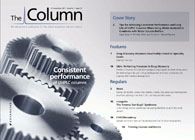Flow splitting to improve peak capacity in on-line LC×LC
The use of flow splitters between the two dimensions in on-line comprehensive two-dimensional liquid chromatography (LC×LC) has received little attention in comparison to their use in two dimensional gas chromatography.
The use of flow splitters between the two dimensions in on-line comprehensive two-dimensional liquid chromatography (LC×LC) has received little attention in comparison to their use in two dimensional gas chromatography.
In principle, the two dimensions should be optimized almost independently if the flow is split after the first dimension column and on‑line LC×LC is performed on this constant fraction of the first dimension effluent. When there is no flow splitting, any change in the first dimension flow-rate has an immediate impact on the second dimension. When there is a flow splitter there is the option to double the flow-rate into the first dimension column and do a 1:1 flow split without changing the sample loop size or the collection time. The sensitivity would be diminished but this can be partially compensated by using a larger injection. This would be a small price to pay for the increased resolving power and system flexibility. Other benefits include a 2-fold increase in the corrected 2D peak capacity and the number of observed peaks for a 15 min analysis time by using a post first dimension flow splitter. At a fixed analysis time the improvement results mainly from an increase in gradient time, which results from the reduced system re-equilibration time. To a lesser extent it is also due to the increased peak capacity achieved by full optimization of the first dimension.1
1. Marcelo Roberto Filgueira et al., Anal. Chem., doi: 10.1021/ac202317m
This story originally appeared in The Column. Click here to view that issue.

Determining the Effects of ‘Quantitative Marinating’ on Crayfish Meat with HS-GC-IMS
April 30th 2025A novel method called quantitative marinating (QM) was developed to reduce industrial waste during the processing of crayfish meat, with the taste, flavor, and aroma of crayfish meat processed by various techniques investigated. Headspace-gas chromatography-ion mobility spectrometry (HS-GC-IMS) was used to determine volatile compounds of meat examined.

.png&w=3840&q=75)

.png&w=3840&q=75)



.png&w=3840&q=75)



.png&w=3840&q=75)









